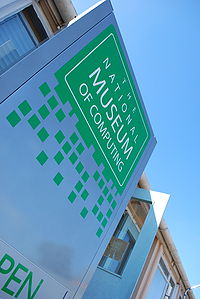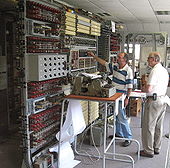- The National Museum of Computing
-
Coordinates: 51°59′55″N 0°44′37″W / 51.9985°N 0.7435°W
The National Museum of Computing 
The EntranceEstablished 2007 Location Bletchley Park, UK Website www.tnmoc.org The National Museum of Computing is a museum in the United Kingdom dedicated to collecting and restoring historic computer systems. The museum is based at Bletchley Park in Buckinghamshire, England, and opened in 2007. The building — Block H — was the first purpose-built computer centre in the world, hosting six Colossus computers by the end of World War II.
The museum houses a rebuilt Colossus computer alongside an exhibition of the most complex code cracking activities performed at the Park, along with examples of machines continuing the history of the development of computing from the 1940s to the present day. The museum has a policy of having as many of the exhibits as possible in full working order.
Contents
Exhibits
On display in the museum are many famous early computing era machines, including a reconstructed Colossus Mark 2, a machine that helped break German encryption during World War II.[1] The Colossus rebuild project and related machines are open to visitors seven days a week.
 In 1994, a team led by Tony Sale began a reconstruction of a Colossus Mark 2 computer at Bletchley Park. Here, in 2006, Sale supervises the breaking of an enciphered message with the completed machine.
In 1994, a team led by Tony Sale began a reconstruction of a Colossus Mark 2 computer at Bletchley Park. Here, in 2006, Sale supervises the breaking of an enciphered message with the completed machine.
The museum includes machines from the 1960s such as the Elliott 803 and 905, an ICL 2966 mainframe from the 1980s, a wide range of analogue computers, a hands-on retrocomputing gallery, and several restoration projects such as the PDP-8 and the PDP-11-based air traffic control system from London Terminal Control Centre at West Drayton near London. Further exhibits include mechanical and electronic calculators, a history of slide rules, and a personal computing gallery with ten hands-on machines.
Another area includes a range of electro-mechanical punched card machines. At the end of 2009, an Internet gallery, sponsored by the National Physical Laboratory where packet switching was first developed, was opened, along with a shop and an education room.
Opening
It is fully open to the public every Thursday and Saturday afternoon and most bank holidays, and by appointment for groups only at other times. There is a modest admission charge to the museum to help cover overheads (including rent).
Funding
TNMOC depends for funding entirely on voluntary and corporate donations and modest admission charges. Fundraising continues and donors have included Bletchley Park Capital Partners, CreateOnline, Ceravision, InsightSoftware.com, PGP Corporation, IBM, NPL, HP Labs, BCS, Black Marble, and the School of Computer Science at the University of Hertfordshire.
The museum is managed by the Codes and Ciphers Heritage Trust,[2] a registered charity,[3] with volunteer staff. The title The National Museum of Computing is an operating name.
Recent announcements
On 23 January 2009, the museum released a press statement [4] announcing that chip tune musician Pixelh8 would be composing and performing an entirely new piece of music for the museum, using some of the "earliest and rarest" machines such as the Colossus computer and the Elliott 803 entitled "Obsolete?".[5][6]
On 3 September 2009, the museum released a press statement [7] announcing that the historic Harwell computer, later known as the WITCH computer, was to be removed from storage to be transferred to The National Museum of Computing at Bletchley Park where it is planned to restore it to full working condition. Once restored by the volunteers at the museum, it will be the oldest original functioning electronic stored program computer in the world and will be housed along with the rebuild of Colossus Mk II, the world’s first electronic computer.
In June 2010, the museum and park hosted the first UK Vintage Computer Festival.[8] Speakers included Sophie Wilson, co-designer of the BBC Micro.
References
- ^ UK computer history gets new home
- ^ The National Museum of Computing
- ^ CODESANDCIPHERS HERITAGE TRUST, Registered Charity no. 1109874 at the Charity Commission
- ^ "Music from vintage computers". The National Museum of Computing News. The National Museum of Computing. 2009-01-23. http://www.tnmoc.org/36/section.aspx/14.
- ^ "BBC News Look East". BBC News. 2009-02-17. http://news.bbc.co.uk/1/hi/england/7895853.stm.
- ^ "Creating modern music on vintage computers". New Scientist. 2009-09-04. http://www.newscientist.com/article/mg20126999.900-making-modern-music-on-vintage-computers.html.
- ^ "Challenge begins to exhibit the world’s oldest, working computer". The National Museum of Computing. 2009-09-03. http://www.tnmoc.org/36/section.aspx/101.
- ^ http://www.tnmoc.org/36/section.aspx/131
External links
Categories:- Museums established in 2007
- Computer museums in the United Kingdom
- Museums in Buckinghamshire
- National museums of the United Kingdom
- Bletchley Park
- Milton Keynes
- Visitor attractions in Buckinghamshire
- Military history of the United Kingdom during World War II
- Signals intelligence of World War II
- History museums in Buckinghamshire
- World War II museums in the United Kingdom
Wikimedia Foundation. 2010.
